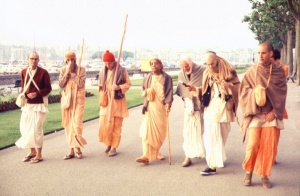SB 11.15.24: Difference between revisions
m (1 revision(s)) |
No edit summary |
||
| Line 1: | Line 1: | ||
{{info | {{info | ||
|speaker=Lord | |speaker=Lord Kṛṣṇa the Supreme Personality of Godhead | ||
|listener=Uddhava | |listener=Uddhava | ||
}} | }} | ||
[[Category:Srimad-Bhagavatam - Canto 11 Chapter 15]] | |||
[[Category:Bhagavatam Verses Spoken by Lord Krsna - Vanisource|111524]] | |||
<div style="float:left">'''[[Srimad-Bhagavatam]] - [[SB 11|Eleventh Canto]] - [[SB 11.15: Lord Krsna's Description of Mystic Yoga Perfections|Chapter 15: Lord Kṛṣṇa's Description of Mystic Yoga Perfections]]'''</div> | |||
<div style="float:right">[[File:Go-previous.png|link=SB 11.15.23]] '''[[SB 11.15.23]] - [[SB 11.15.25]]''' [[File:Go-next.png|link=SB 11.15.25]]</div> | |||
{{RandomImage}} | |||
{{SBnotice}} | |||
==== TEXT 24 ==== | ==== TEXT 24 ==== | ||
<div | <div class="verse"> | ||
pārṣṇyāpīḍya gudaṁ prāṇaṁ | :pārṣṇyāpīḍya gudaṁ prāṇaṁ | ||
hṛd-uraḥ-kaṇṭha-mūrdhasu | :hṛd-uraḥ-kaṇṭha-mūrdhasu | ||
āropya brahma-randhreṇa | :āropya brahma-randhreṇa | ||
brahma nītvotsṛjet tanum | :brahma nītvotsṛjet tanum | ||
</div> | </div> | ||
| Line 17: | Line 22: | ||
==== SYNONYMS ==== | ==== SYNONYMS ==== | ||
<div | <div class="synonyms"> | ||
pārṣṇyā—with the heel of the foot; āpīḍya—blocking; gudam—the anus; prāṇam—the vital air carrying the living entity; hṛt—from the heart; uraḥ—to the chest; kaṇṭha—to the neck; mūrdhasu—and to the head; āropya—placing; brahma-randhreṇa—by the spiritual seat at the top of the head; brahma—to the spiritual world or impersonal Brahman (or any other destination one has selected); nītvā—leading (the soul); utsṛjet—one should give up; tanum—the material body. | pārṣṇyā—with the heel of the foot; āpīḍya—blocking; gudam—the anus; prāṇam—the vital air carrying the living entity; hṛt—from the heart; uraḥ—to the chest; kaṇṭha—to the neck; mūrdhasu—and to the head; āropya—placing; brahma-randhreṇa—by the spiritual seat at the top of the head; brahma—to the spiritual world or impersonal Brahman (or any other destination one has selected); nītvā—leading (the soul); utsṛjet—one should give up; tanum—the material body. | ||
</div> | </div> | ||
{{SBcollapse}} | |||
==== TRANSLATION ==== | ==== TRANSLATION ==== | ||
<div | <div class="translation"> | ||
The yogī who has achieved the mystic perfection called svacchanda-mṛtyu blocks the anus with the heel of the foot and then lifts the soul from the heart to the chest, to the neck and finally to the head. Situated within the brahma-randhra, the yogī then gives up his material body and guides the spirit soul to the selected destination. | The yogī who has achieved the mystic perfection called svacchanda-mṛtyu blocks the anus with the heel of the foot and then lifts the soul from the heart to the chest, to the neck and finally to the head. Situated within the brahma-randhra, the yogī then gives up his material body and guides the spirit soul to the selected destination. | ||
</div> | </div> | ||
| Line 31: | Line 36: | ||
==== PURPORT ==== | ==== PURPORT ==== | ||
<div | <div class="purport"> | ||
This mystic opulence of svacchandu-mṛtyu, or dying at will, was wonderfully exhibited by Bhīṣmadeva at the end of the Battle of Kurukṣetra. According to Śrīla Śrīdhara Svāmī, the term brahma, as used in this verse, is an example of upalakṣaṇa, or the use of a general term to indicate various concepts. Brahma here indicates the particular destination selected by the yogī, namely the spiritual sky, the impersonal brahmajyoti or any other destination that has attracted the yogī's mind. | This mystic opulence of ''svacchandu-mṛtyu'', or dying at will, was wonderfully exhibited by Bhīṣmadeva at the end of the Battle of Kurukṣetra. According to Śrīla Śrīdhara Svāmī, the term ''brahma'', as used in this verse, is an example of ''upalakṣaṇa'', or the use of a general term to indicate various concepts. ''Brahma'' here indicates the particular destination selected by the ''yogī'', namely the spiritual sky, the impersonal ''brahmajyoti'' or any other destination that has attracted the ''yogī's'' mind. | ||
</div> | </div> | ||
__NOTOC__ | </div> | ||
</div> | |||
<div style="float:right">[[File:Go-previous.png|link=SB 11.15.23]] '''[[SB 11.15.23]] - [[SB 11.15.25]]''' [[File:Go-next.png|link=SB 11.15.25]]</div> | |||
__NOTOC__ | |||
__NOEDITSECTION__ | |||
Revision as of 14:21, 30 June 2021

A.C. Bhaktivedanta Swami Prabhupada
Please note: The synonyms, translation and purport of this verse were composed by disciples of Śrīla Prabhupāda
TEXT 24
- pārṣṇyāpīḍya gudaṁ prāṇaṁ
- hṛd-uraḥ-kaṇṭha-mūrdhasu
- āropya brahma-randhreṇa
- brahma nītvotsṛjet tanum
SYNONYMS
pārṣṇyā—with the heel of the foot; āpīḍya—blocking; gudam—the anus; prāṇam—the vital air carrying the living entity; hṛt—from the heart; uraḥ—to the chest; kaṇṭha—to the neck; mūrdhasu—and to the head; āropya—placing; brahma-randhreṇa—by the spiritual seat at the top of the head; brahma—to the spiritual world or impersonal Brahman (or any other destination one has selected); nītvā—leading (the soul); utsṛjet—one should give up; tanum—the material body.
Translation and purport composed by disciples of Śrīla Prabhupāda
TRANSLATION
The yogī who has achieved the mystic perfection called svacchanda-mṛtyu blocks the anus with the heel of the foot and then lifts the soul from the heart to the chest, to the neck and finally to the head. Situated within the brahma-randhra, the yogī then gives up his material body and guides the spirit soul to the selected destination.
PURPORT
This mystic opulence of svacchandu-mṛtyu, or dying at will, was wonderfully exhibited by Bhīṣmadeva at the end of the Battle of Kurukṣetra. According to Śrīla Śrīdhara Svāmī, the term brahma, as used in this verse, is an example of upalakṣaṇa, or the use of a general term to indicate various concepts. Brahma here indicates the particular destination selected by the yogī, namely the spiritual sky, the impersonal brahmajyoti or any other destination that has attracted the yogī's mind.